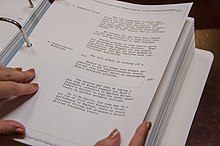President's Daily Brief
The President's Daily Brief ( PDB ) is presented to the President of the United States on a daily basis. It presents the most important current findings of the American secret services. The National Secret Service Director decides on the composition .
The top secret report is usually 10-15 pages long (other source: 12-30 pages)
history
The forerunner of the PDB was created in 1961 out of dissatisfaction on the part of John F. Kennedy with intelligence information following the failed Bay of Pigs invasion . The first PDB was prepared by Richard Lehman under the director of the Office of Current Intelligence Huntington D. Sheldon on June 17, 1961. It initially contained daily information in the form of a list with brief sections , compiled exclusively for the President, and later also for the Secretary of Defense and the Chairman of the Joint Chiefs of Staff . Kennedy read and evaluated the list independently, only when necessary he consulted or asked for additional information.
After Kennedy's assassination in 1963, the Director of Central Intelligence initially informed the new President Johnson personally using the list he had prepared. After tensions increased over the assessment of the Vietnam War in 1964 , Johnson decided not to meet in person and hardly read the prepared list. Since January, the list had only appeared twice a week in the form of a report, but it was now also available to a number of other employees. Because Johnson continued to pay little attention to the report and at the same time worries about improper distribution increased, it was decided to abandon the report and create a new form - for fewer addressees.
On December 1, 1964, the new President's Daily Letter was delivered to Johnson for the first time, and it was published in the late afternoon to suit the President's custom. Johnson read the report regularly and decided in 1965 that he wanted it to be presented at 6:30 a.m. On August 6, 2001, a President's Daily Letter from the Central Intelligence Agency , entitled Bin Ladin Determined To Strike in US , was presented to George W. Bush by the Central Intelligence Agency . The executive summary warned of a terrorist threat from Osama bin Laden and al-Qaeda . The terrorist attacks on September 11, 2001 were carried out 36 days later .
The existence of this warning was kept secret. In 2002 a whistleblower proved their existence and CBS Evening News reported on May 15, 2004.
In culture
The PDB Bin Ladin Determined To Strike in US is mentioned in Michael Moore's documentary Fahrenheit 9/11 .
literature
- Michael A. Genovese: Encyclopedia of the American Presidency . Revised Edition. 1st edition. Facts on File, New York 2010, ISBN 978-0-8160-7366-5 , pp. 407 f . ( online in Google Book Search).
Web links
- CIA Briefings of Presidential Candidates
- Mr. Current Intelligence: An Interview with Richard Lehman
- National Security Archive at George Washington University
- August 6, 2001 PDB from CNN , (.PDF; 220 kB)
Individual evidence
- ↑ Matthias Rüb: Before taking office: Obama's brave new world . In: faz.net . Frankfurter Allgemeine Zeitung. November 6, 2008. Archived from the original on April 30, 2011. Retrieved on April 30, 2011.
- ↑ John Diamond, Judy Keen: Bush's daily intel briefing revamped ( English ) In: usatoday.com . USA Today . August 24, 2005. Archived from the original on May 1, 2011. Retrieved on May 1, 2011.
- ↑ Robert Windrem: What is the President's Daily Brief? ( English ) In: MSNBC Interactive . MSNBC . December 4, 2004. Archived from the original on May 1, 2011. Retrieved May 1, 2011.
- ↑ a b c John L. Helgerson: CIA Briefings of Presidential Candidates ( English , pdf) In: Center for the Study of Intelligence . Central Intelligence Agency. May 22, 1996. Archived from the original on May 1, 2011. Retrieved May 1, 2011.
- ^ A b Thomas S. Blanton: The President's Daily Brief . National Security Archive . April 12, 2004. Retrieved October 17, 2013.
- ^ Paul Thompson: The Terror Timeline . HarperCollins, 2004, ISBN 0-06-078338-9 , p. 100.
- ↑ http://www.imdb.com/title/tt0361596/quotes
